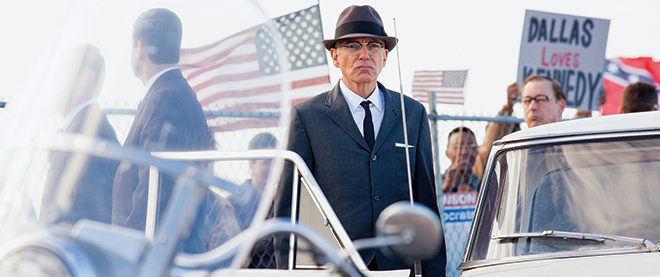‘Parkland’ gives J.F.K. back to the people
The assassination through the eyes of ordinary Americans
Claire Folger / Exclusive Media Entertainment
Share

This Nov. 22 will mark the 50th anniversary of an event that was the pivotal tragedy of modern America, at least until 9/11. The shots that rang out on a sunny Friday in Dallas, killing president John F. Kennedy, not only shattered the nation’s aura of postwar innocence, but inaugurated a cycle of murderous spectacle that now plays almost routinely in real time on camera—from terrorist attacks to mass shootings. The Kennedy assassination, frozen in cultural memory as a series of unforgettable frames, has become enshrined in myth and conspiracy theories.
Now Parkland jolts it back to life with a raw, vérité drama that plunges us back into the fray. The film focuses on an ensemble of characters whose lives were forever changed on Nov. 22, 1963. They range from Agent Forrest Sorrels (Billy Bob Thornton), the Secret Service chief who lost the president on his watch, to Dr. Charles Carrico (Zac Efron), the ER resident who struggled to save him, only to have a mortally wounded Lee Harvey Oswald land in his ward two days later. Named after the Dallas hospital where J.F.K. and Oswald died, Parkland is about the collateral damage to bystanders caught in the crossfire of a national tragedy.
Based on Vincent Bugliosi’s 2008 book Four Days in November, the movie marks an audacious feature debut for U.S. writer-director Peter Landesman, a former investigative journalist and war correspondent. “I wanted to take the assassination out of the murder mystery and give it back to the people,” Landesman told Maclean’s. He says he and producer Tom Hanks had two rules: “Everything is verifiably true and nothing in the movie is anything anyone’s seen before.”
Despite the film’s eye for authentic detail, the director didn’t want it to play like a period piece. “I wanted that in-our-face immediacy,” he says. “From being in south Manhattan on 9/11 to the experience I’ve had in war zones, the emotional DNA of surviving a cataclysmic event looks the same: a woman loses her husband, a doctor loses a patient, a cop loses the person he’s guarding.”
With a blood-drenched ER scene that shows Jackie Kennedy still clutching a piece of her husband’s brain, Parkland portrays the impact of the assassination in unprecedented graphic detail. Its unflinching documentary style, which tries to embed the viewer in the moment, carries the kinetic signature of British cinematographer Barry Ackroyd, who shot United 93, The Hurt Locker—and next month’s Captain Phillips, starring Hanks in the true story of a Somali pirate hijacking. But Landesman is trespassing on hallowed ground, which has offended some U.S. critics. Even after 50 years, the assassination is a loaded subject.
The last Hollywood movie to mess with it was Oliver Stone’s 1991 conspiracy thriller JFK. “It’s a fairy tale,” says Landesman, who calls himself a friend of Stone. “I don’t know what was in Oliver’s head when he wrote it. But Parkland doesn’t pick a fight with it. These two movies can live side by side: JFK is an intellectual chess game and Parkland is an emotional vortex. It’s as if you’re experiencing the assassination for the first time.”
The most poignant figures to emerge from Parkland are two decent men cursed with unwanted celebrity: Abraham Zapruder (Paul Giamatti), whose 8-mm home-movie footage of the assassination became the most historic few seconds of film ever shot, and Oswald’s brother Robert (James Badge Dale). Zapruder, who comes to resent his fame, is the unwitting forerunner of an age in which no event goes unphotographed. But the assassin’s brother emerges as the film’s unlikely hero, struggling to maintain some dignity while his diva-like mother, Marguerite Oswald (Jacki Weaver), acts like she’s auditioning for a reality show not yet invented. “Robert Oswald is us,” says Landesman. “He’s Everyman. He kissed his wife and two kids goodbye, went to work as a paper-pusher. Then he gets a phone call and realizes he’s in the middle of history and his brother is the devil.” In the film’s most moving scene, the director has the nerve to intercut J.F.K.’s funeral with that of his assassin—who’s buried at a gravesite so desolate that Robert is forced to enlist the paparazzi as pallbearers.